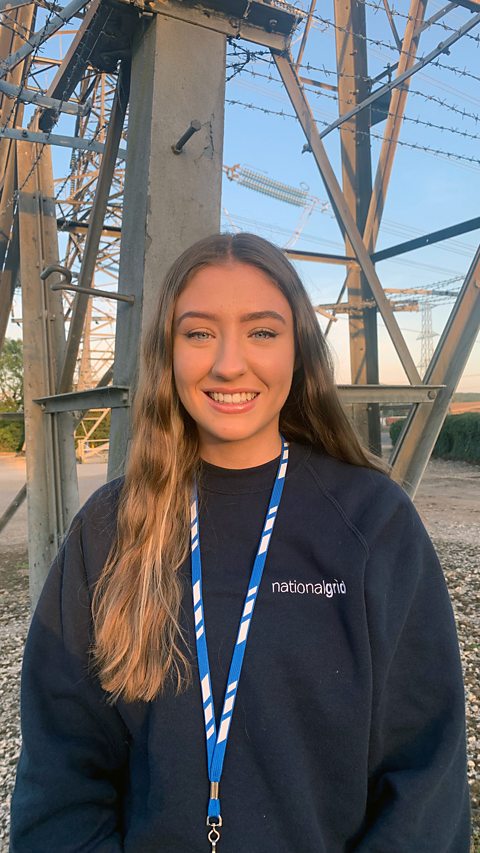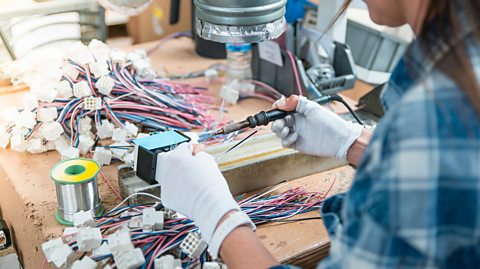Around the world, governments are trying to make their countries reach ânet zeroâ carbon emissions by 2050. Net zero means having a âzeroâ balance between the amount of greenhouse gases being put into the atmosphere and those taken out.
To support this target, âgreen jobsâ are being created in the UK which will help energy companies, other businesses and households find ways to reduce harmful emissions. That means there are some exciting job opportunities for young people in the energy sector and beyond!
±«Óătv Bitesize has been speaking to Dina Potter, Global Head of Social Impact at gas and electricity company National Grid, and Rhian Kelly, Corporate Affairs Director at National Grid and Member of the Green Jobs Taskforce.
What are green jobs?
There are a lot of definitions of âgreen jobsâ. They can be roles in companies that are trying to create renewable energy, or reduce waste and pollution. They may also be in companies that make goods or services, or organisations that look after our natural resources and ecosystems. Or green jobs might be in companies that are helping other businesses and communities to adapt to climate change.
What kind of jobs are available in the energy industry?

As you may expect, there are engineering roles available, like mechanical, civil and electrical engineering. Rhian Kelly says these jobs are for everyone: "Engineering can feel male-dominated but we are keen to get people from all walks of life into the energy sector."
Energy companies also need all the roles involved in running a large organisation â like human resources (HR), IT, communications, property and business management.
Rhian Kelly says there will also be some new jobs created that do not even exist yet.
Engineering can feel male-dominated but we are keen to get people from all walks of life into the energy sector.
â Rhian Kelly

What kind of qualifications do you need?

There are many different routes into green jobs, including options for those who dropped out of school or who cannot afford the academic routes.
For example, the âGrid for Goodâ scheme is for young people from a disadvantaged background who do not have prior experience, but who can learn about a job through work placements.
There are also apprenticeship programmes at different levels of entry, from advanced to higher and degree apprenticeships. You will usually need at least five GCSEs or equivalent with grades 9 to 4 (A* to C) to start on an advanced apprenticeship. There is also a range of graduate schemes.
Rhian says you do not need to be an engineer to apply for some of these roles: âI was an arts student and ended up working for an engineering company in the energy sector.â
She adds: âBecause weâve got the challenges to deliver the climate change targets, because things are changing so fast, we need young people in the sector from all walks of life. We need a fresh perspective and fresh ideas.â
Read Jade's story: she's doing an apprenticeship and is training to become a substation engineer.

How will someone be helping the environment by working in this sector?

Rhian says her company has done a lot of work on things that will help the environment, like electric vehicle charging, developing hydrogen as a new fuel, offshore wind energy and capturing and storing emissions underground. All this activity is helping to deliver ânet zeroâ.
When thinking about what company you might want to work for, you could also consider how that company is encouraging employees to be more green. For example, do they use the government Cycle2Work scheme, what kind of company cars do they use, and what is their international travel plan?
All jobs are going to have a green element to them in the next 20 years.
â Rhian Kelly
What is it like working in the energy sector?
Rhian and Dina are both very enthusiastic about their jobs. Rhian says: âI like the purpose of trying to tackle climate change⊠I like the big infrastructure and the clean tech weâre investing in too. I think itâs really cool!â
Dina is excited by the influx of new, young talent that is coming into the sector, and loves how much she enjoys her job, having joined the industry over 20 years ago: âI was going to be an interior designer! I thought Iâd do five years when I came in on the graduate scheme but itâs such a diverse industry, it is changing and it is so relevant now more than ever. I love the fact that if you work here you can say you did something towards climate change.â


Top tips for getting into the energy sector
- Work out which organisation you might like to work for and which sectors. Search for companies and go on their websites
- Look at company careers pages, as well as other more generic careers sites
- Remember National Graduate Week in October and National Apprenticeship week in February
- For graduates, go to recruitment fairs, talk to people and find out more. Ask questions
- Donât rule out working in the energy sector â it might be âcoolerâ than you think!

Jade: substation engineer apprentice
Jade is doing a Level 4 higher apprenticeship, training to become a substation engineer.

Job inspiration: Roles to help protect the planet. collection
Check out our collection of planet-friendly jobs to inspire your future career path.

